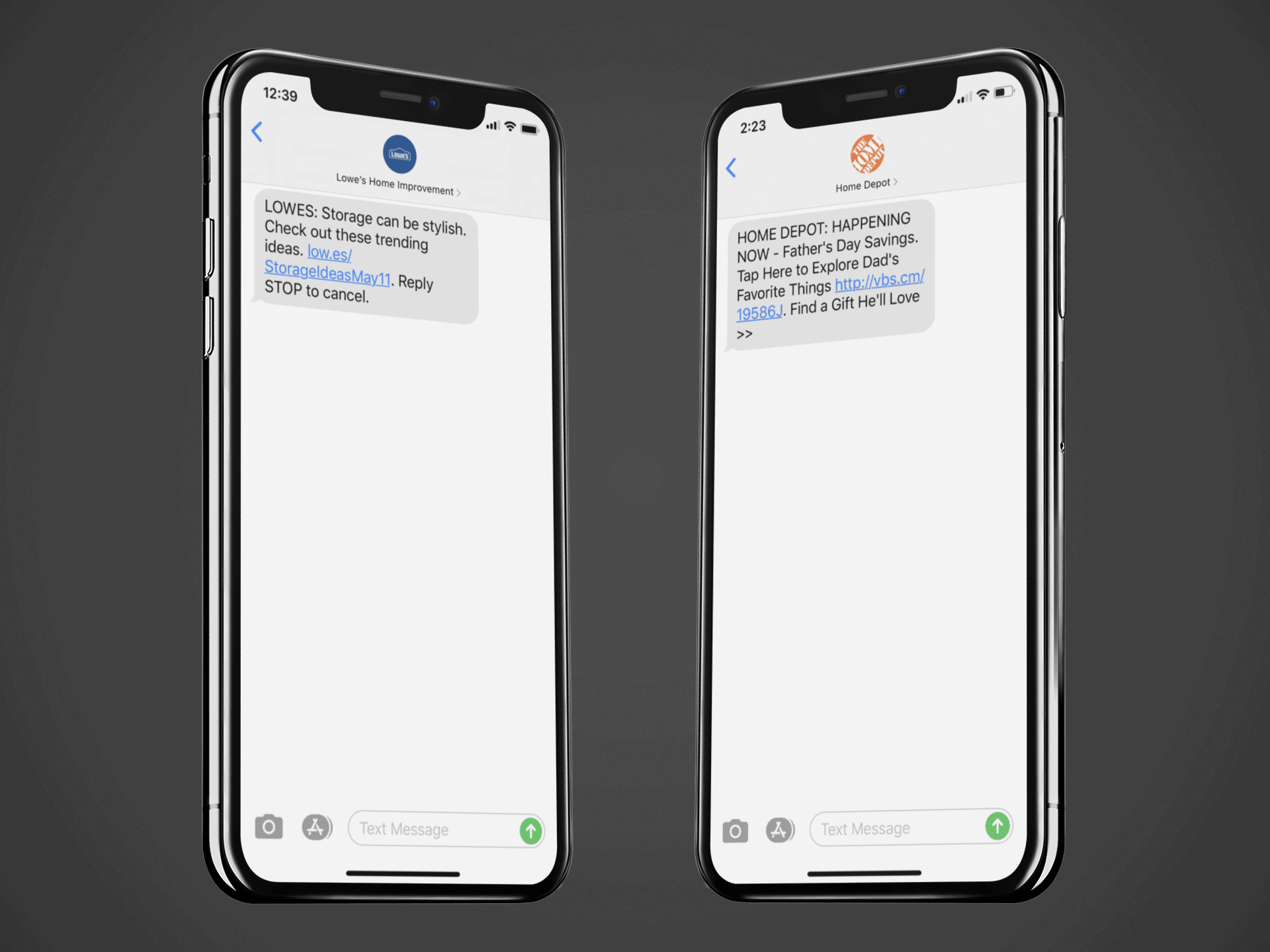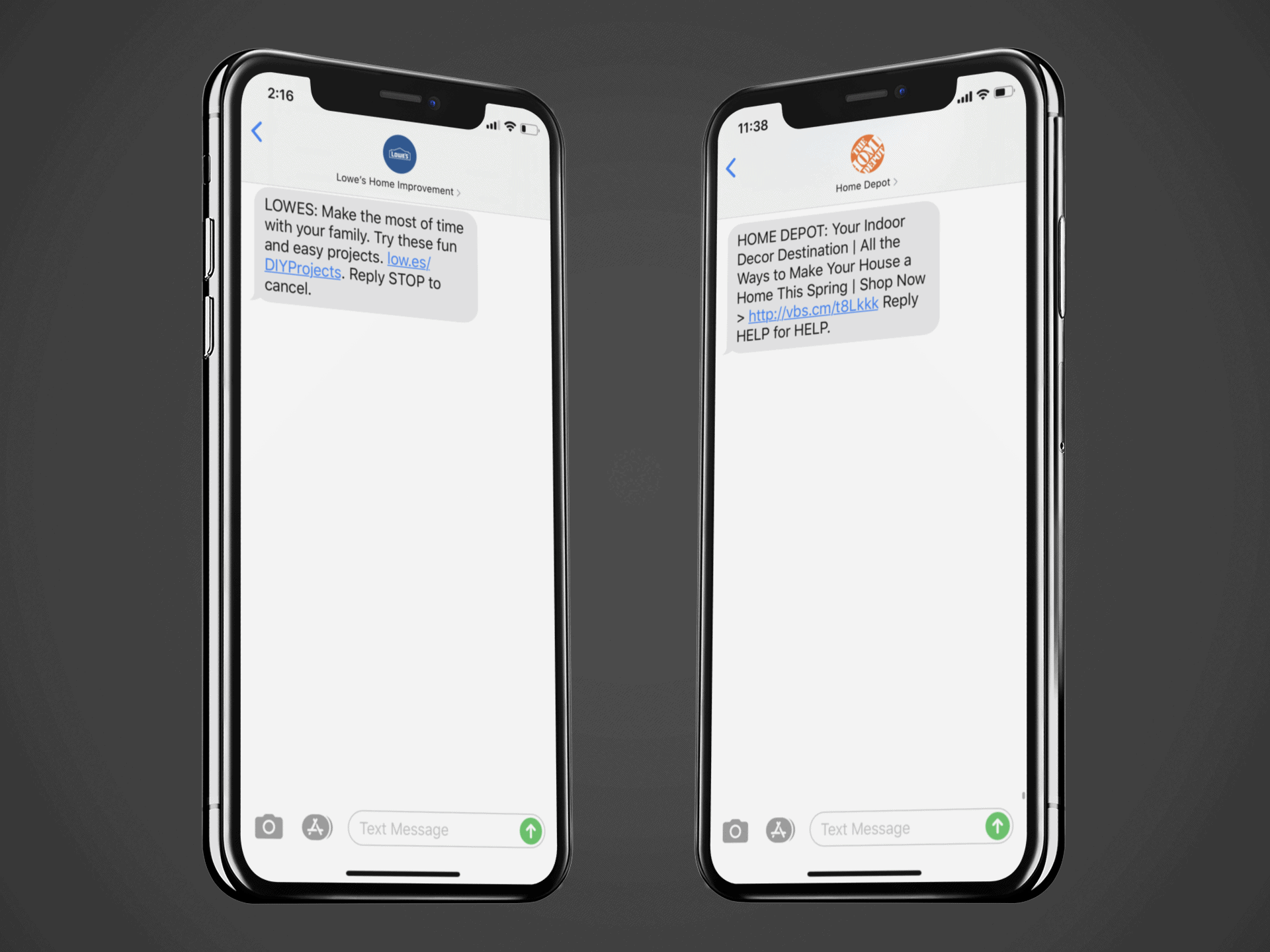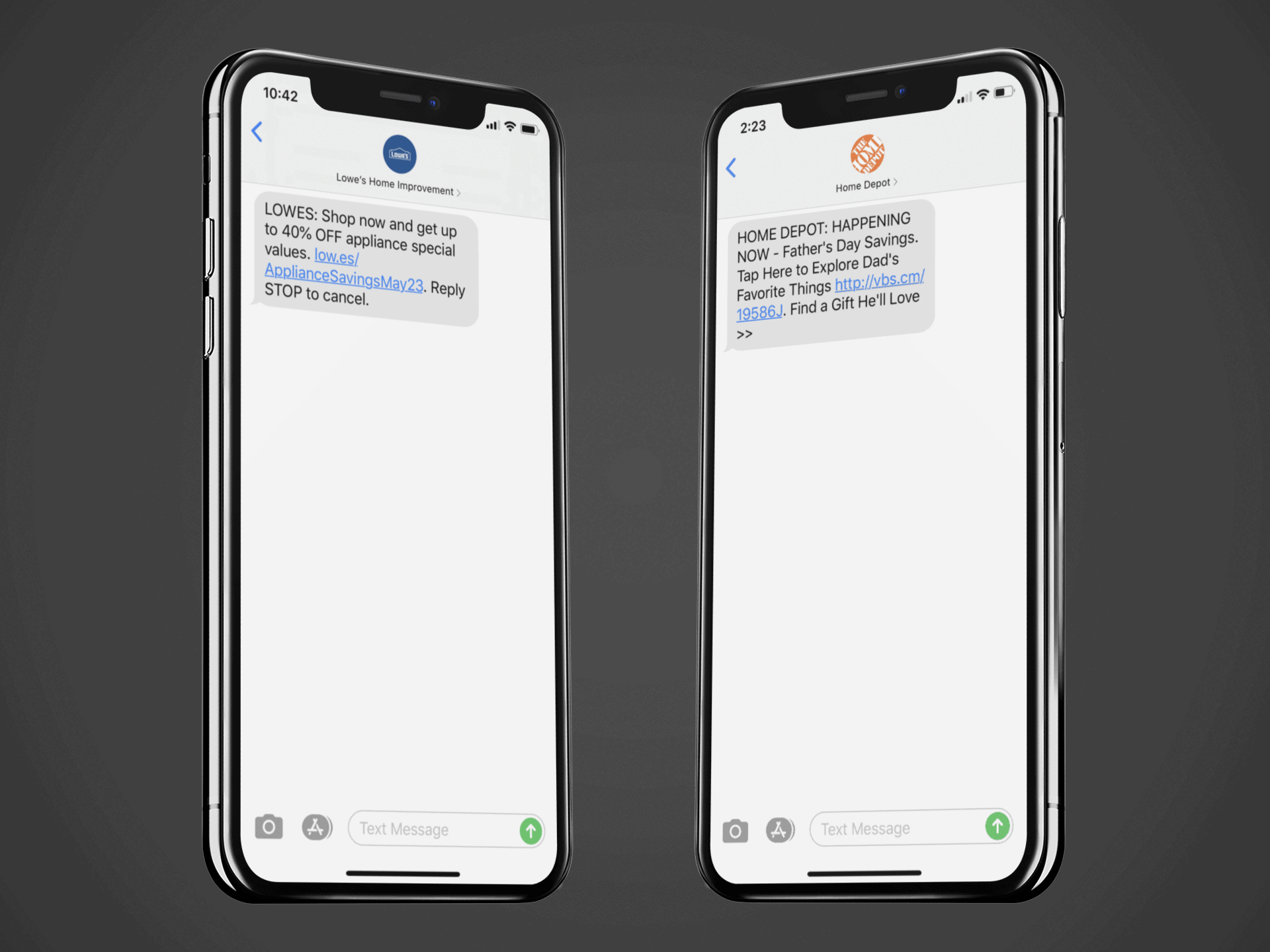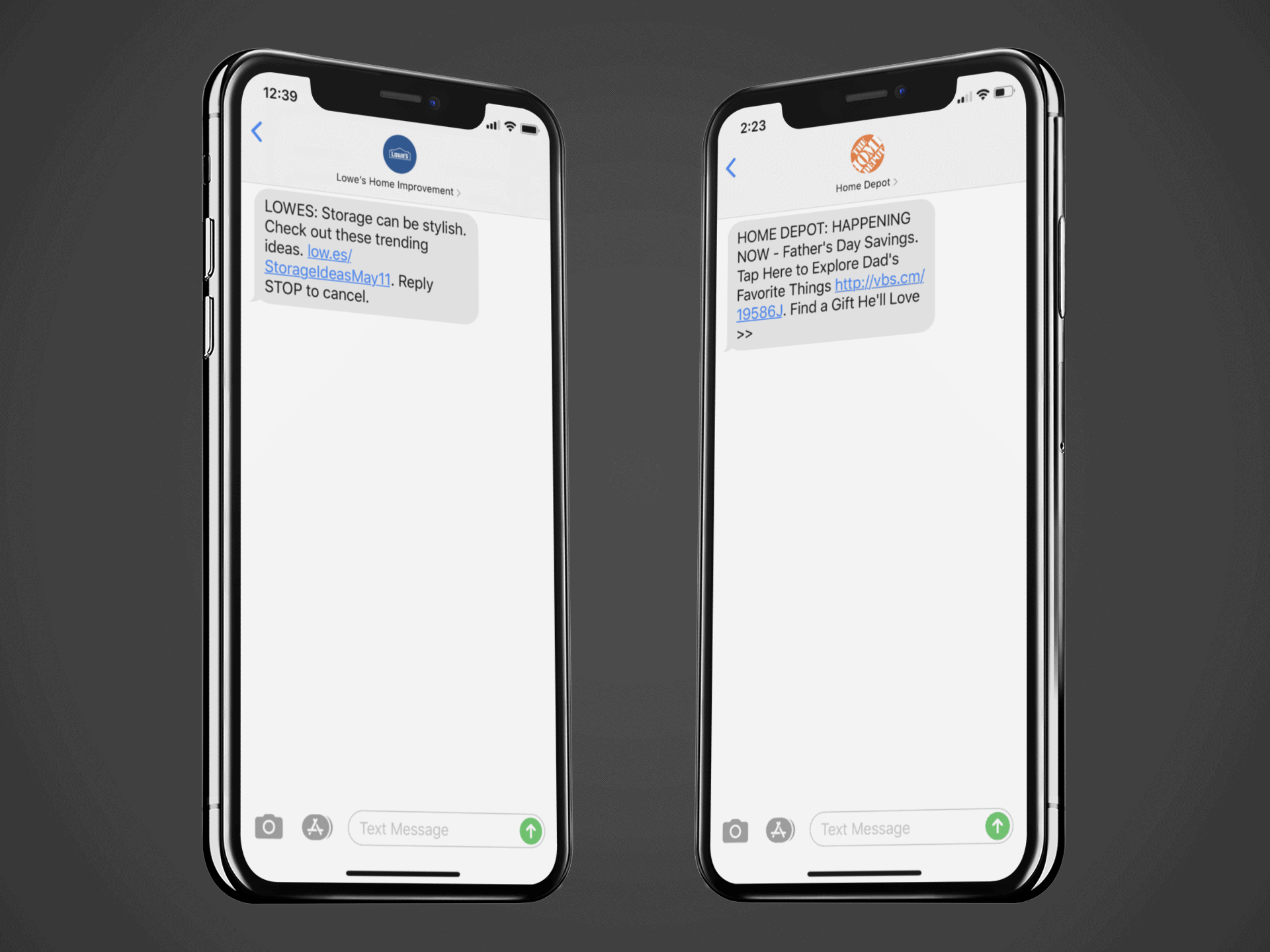
It’s the ultimate home and garden showdown: Lowe’s vs. Home Depot SMS marketing. Both of these powerhouse companies sell all of your home improvement needs, from appliances to patio furniture, power tools, BBQ grills, carpet and tile flooring, lawn and garden supplies, and more. We thought it would be fun to compare these two top brands and their text message marketing strategies. You can see an archive of the message each company has sent on SMS Archives, the first and only search engine for SMS marketing. We break it down for you below.
Lowe’s Text Messages vs. Home Depot Text Messages: Similarities
While there are a few things that these brands do differently, there are also quite a few similarities. Let’s first examine what these home-tool titans have in common.
Similarity #1: Both Start With Brand Name

As you can see above, both companies always start their mass text messages with their brand name. This is a solid strategy, as subscribers know right away who they are receiving a text from. Consumers may subscribe to dozens of their favorite brands, so it’s not enough to simply start with an offer. You want to ensure people are clear on who they are getting a deal from right at the start of the message.
Similarity #2: Both Use Mainly SMS Messaging

Another commanality is that both brands use predominately SMS messages, which are text messages with purely text — no images, gifs, or videos, as in MMS messages. As you can see on SMS Archives, Lowe’s uses SMS messaging approximately 91% of the time, while Home Depot uses SMS messaging 100% of the time.
Why would companies benefit from mixing up their text message marketing strategy by using MMS messaging? The main benefit of MMS is that it makes for more engaging text messages. It’s one thing to read about patio furniture, but if you see a picture of your dream patio in a text message, then you’re more likely to click through and purchase those items. We think it would be interesting to see one or both brands use MMS messaging, and see how that impacts who generates more profits from their text message marketing campaigns.
Similarity #3: Both Offer Exclusive Content to SMS Subscribers

One final interesting note about Lowe’s and Home Depot’s text messages is that they both mix in valuable tips and tricks so their subscribers get additional value from the text message marketing campaigns.
Lowe’s offers ideas for fun home DIY projects, while Home Depot teaches subscribers how to make their house feel like a home during spring. Both Home Depot and Lowe’s aim to get people to their websites by offering free value, tips, and ideas — similar to a blog post — which can then result in purchases as customers click around. Sales-based texts about savings only come every few text messages.
According to SMS Archives, Lowe’s sends text messages every 7.6 days on average, which is about twice as often as Home Depot, which sends text messages every 4.4 days on average.
Lowe’s Text Messages vs. Home Depot Text Messages: Differences
Now that we have an idea about the similarities between Home Depot and Lowe’s text message marketing, let’s check out a few differences.
Difference #1: Customization of Hyperlinks in SMS Messages

As you can see above, Lowe’s customizes their SMS marketing hyperlinks. Lowe’s does this not only for the front of the URL, with the short link reading as “low.es”, but for the ending of the URL as well, which reads “ApplianceSavings”. For example, when Lowe’s sends a text message about appliance savings, their link is low.es/ApplicanceSavings. Smart, right? Even the use of capitalization in the slug makes the link more readable.
Similarly, when Lowe’s sends a message about securing one’s home, their link is low.es/SecureSafeHome. This instantly creates more trust with consumers, who now know exactly where the link will take them, and it also gives Lowe’s a second chance to grab subscriber attention if the subscriber glossed over the rest of the text message. The bright blue link calls out the topic clearly.
While the look of the hyperlinks differs, it’s wise of both Home Depot and Lowe’s to include trackable links in their SMS messaging. If these brands just gave subscribers a coupon code and told them to use it in-store, Lowe’s and Home Depot would have no idea whether or not the text actually led to someone shopping in-store. But by including a measurable link, Lowe’s and Home Depot know exactly who clicks through to a website from their text messages and makes a purchase.
This strategy enables Lowe’s and Home Depot to improve their text message marketing over time. After a while, they will get a baseline for how well their links perform. If they notice one link underperform, they can investigate to see what could have caused this, such as the message topic, message copy, or call-to-action. This allows Lowe’s and Home Depot to test and improve. They can measure whether adding an image, gif, or video increases click-through-rates. By incrementally improving over time, these companies can get more revenue out of every single one of their text messages.
Difference #2: CTA Location in SMS Messages

Another interesting thing that we noticed in Home Depot text messages is that Home Depot sometimes puts the call-to-action before the link, and sometimes after. Lowe’s text message places the CTA before the link, saying “Shop now and get up to 40% OFF appliance special values.”
However, Home Depot’s text message includes two CTAs, placing one after the hyperlink saying “Find a Gift He’ll Love >>.” That’s an interesting choice, as it leaves subscribers with the call-to-action phrase as the very last thing they see.
Either way, the best part about a solid text message marketing platform is that you can measure everything to see which format performs best. With that thinking, there is no one wrong way to send a mass text message; test new things and you might find new unsuspected formats that perform even better.
Difference #3: Use of Help vs. Stop Commands in Text Messages

One final difference between these two companies is how they use HELP and STOP commands. Lowe’s includes the opt-out line (“Reply STOP to cancel”) in just about every text message. While you legally only have to do this once per month, this best practice helps Lowe’s reduce the risk of a TCPA violation for someone claiming that Lowe’s messaged the consumer without their consent. All a subscriber has to do is opt-out if they no longer want messages, which Lowe’s makes super clear with instructions in every text message.
Home Depot, on the other hand, uses STOP less frequently, but intersperses HELP commands (“Reply HELP for HELP”) more often instead. While this isn’t legally required, except in the first confirmation text once a subscriber opts into your text message marketing program, it’s a fine best practice because the instructions can be seen as helpful by subscribers.
See More Text Messages from Lowe’s and Home Depot
If all this text talk has you itching to start some home improvement projects, you too can sign up for Lowe’s or Home Depot text message coupons.
Sign up for Lowe’s text messages sent straight to your phone.

Sign up for Home Depot text messages and get a $5 coupon with a $50 purchase.

Or, sign up for both to stay updated about which new text message marketing strategies these brands use. Let us know in the comments if you enjoyed this showdown and would like to see how other competitor text message marketing programs compare!

